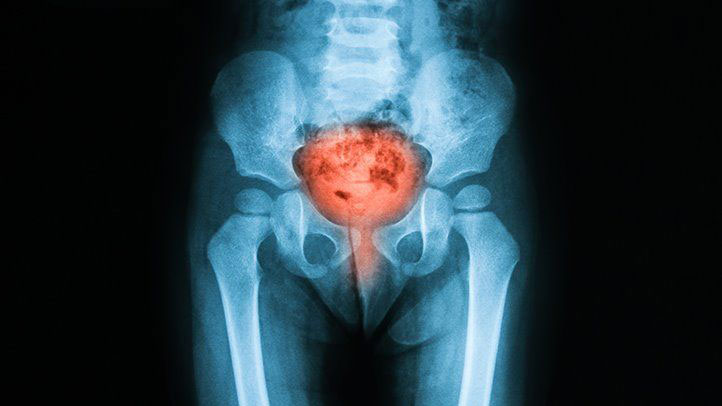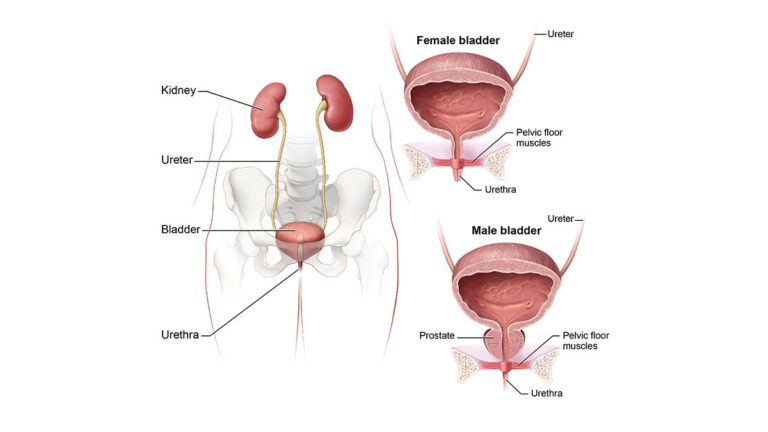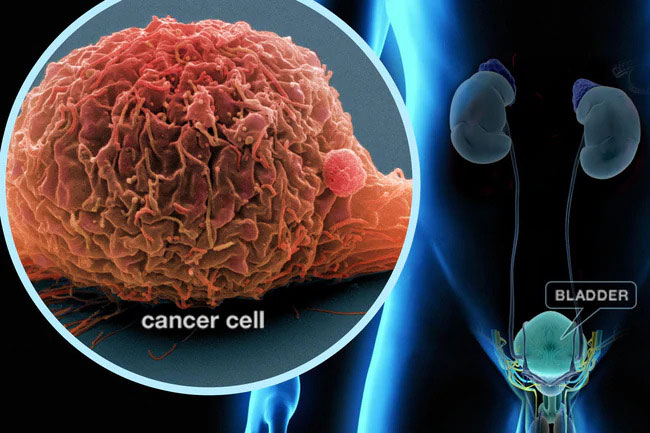BLADDER PAIN – SYMPTOMS, CAUSES, AND TREATMENT
The bladder is a hollow, balloon-like muscle in the middle of your pelvis. It expands and contracts as it fills up and drains your urine. As part of your urinary system, your bladder holds the urine that is passed to it from your kidneys via two small tubes known as ureters before being released through your urethra.
Bladder pain could affect men and women and be caused by a few different conditions some more severe than others. We will explore the different causes of bladder pain, what other symptoms to look out for, and treatment alternatives.

BLADDER PAIN CAUSES
Bladder pain of any kind needs investigation because it has several possible causes, from a urinary tract infection to chronic bladder swelling.
1. Urinary Tract Infection
A urinary tract infection (UTI) is a bacterial infection along any part of your urinary tract, involving the bladder. Men and women could get urinary tract infections (UTIs), but they are more common in women.
Urinary tract infections (UTIs), are caused by bacteria that enter the bladder through the urethra. When left untreated, urinary tract infections (UTIs) could spread to your kidneys and bloodstream causing severe complications.
Urinary Tract Infection Symptoms
Along with bladder pain, a urinary tract infection (UTI) might also cause any of the following symptoms:
- Frequent painful urination
- Lower abdominal pain
- Low back pain
- Bladder/pelvic pressure
- Cloudy urine
- Blood in urine
Urinary Tract Infection Diagnosis
Your doctor or primary care physician could diagnose a urinary tract infection using urinalysis to check your urine sample for white and red blood cells, and bacteria. Your doctor or primary care physician might also use a urine culture to determine the type of bacteria present.
If you have recurrent urinary tract infections (UTIs), your doctor or primary care physician might suggest further testing to check for abnormalities in your bladder or urinary tract. These tests might include:
- Ultrasound
- Magnetic Resonance Imaging (MRI)
- Computed Tomography (CT) scan
- Cystoscope
Urinary Tract Infection Treatment
Urinary tract infections (UTIs) are treated with oral antibiotics to kill the bacteria. Your doctor or primary care physician might also prescribe a pain medication to relieve pain and burning. Frequent urinary tract infections (UTIs) might need a longer course of antibiotics. Serious urinary tract infections (UTIs) and complications might need antibiotics given through an intravenous (IV) in a hospital.

2. Interstitial Cystitis / Painful Bladder Syndrome
Interstitial cystitis, also described as bladder pain syndrome, is a chronic condition that causes painful urinary symptoms. It affects mostly women, as per the National Institute of Diabetes and Digestive and Kidney Diseases (NIDDK). The cause of the condition is currently not known, but specific factors might trigger symptoms, like infections, physical or emotional stress, diet, bladder injury, or specific medications.
Interstitial Cystitis Symptoms
The symptoms could range from mild to severe and vary from person to person. Symptoms could include:
- Strong urgency to urinate
- Frequent urination
- Burning or pain with the requirement to urinate
- Bladder pain
- Pelvic pain
- Abdominal pain
- Pain between the vagina and anus (women)
- Pain between the scrotum and anus (men)
- Painful intercourse
Interstitial Cystitis Diagnosis
Your doctor or primary care physician might use the following tests to diagnose interstitial cystitis:
- Medical history, including symptoms
- Bladder log of your fluid intake and the volume of urine you pass
- Pelvic examination (women)
- Prostate examination (men)
- Urinalysis to check for infection
- Cystoscopy to check the lining of your bladder
- Urinary function tests
- Potassium sensitivity test
Your doctor or primary care physician might also perform other tests to help rule out cancer as the cause of your symptoms, like a biopsy, which is generally performed during cystoscopy or urine cytology to check the presence of cancer cells in your urine
Interstitial Cystitis Treatment
There is no one certain treatment for interstitial cystitis. Your doctor or primary care physician will recommend treatments for your individual symptoms, which might include:
Lifestyle changes – The changes suggested will be based on what you feel your triggers are. These usually include quitting smoking, avoiding alcohol, and dietary changes. Some people find that easy exercise and stress reduction help relieve symptoms.
Medication – Over-the-counter (OTC) pain medications might help relieve pain. Prescription medications like Tricyclic antidepressants might help relax your bladder and block pain. Pentosan polysulfate sodium (Elmiron) is approved by the food and drug administration (FDA) to treat the condition.
Bladder training – Bladder training might help your bladder to hold more urine. It involves tracking how usually you urinate and slowly extending the time between urinating.
Physical therapy – A physical therapist who specializes in the pelvis could help you stretch and strengthen your pelvic floor muscles and learn to keep them relaxed, which might help relieve your symptoms, involving pelvic floor muscle spasms.
Bladder instillation – A small amount of liquid containing medication to relieve irritation is placed in your bladder and held in for approximately fifteen minutes before releasing it. The treatment could be repeated weekly or biweekly for one or two months.
Bladder stretching – The bladder is stretched by filling it with liquid. You will be given medication to help you hold the liquid and tolerate the stretching. Some people experience a momentary relief of symptoms after bladder stretching.
Transcranial magnetic stimulation – A small 2018 study found that repetitive transcranial magnetic stimulation improved chronic pelvic pain and related urinary disorders in people with bladder pain syndrome.
Surgery – Surgery is only suggested if all other treatments have failed to provide relief and your symptoms are serious. Surgery might include bladder augmentation or enlargement, a cystectomy to remove the bladder, or urinary diversion to divert your urine flow.
3. Bladder Cancer
Bladder cancer occurs when cells in the bladder grow uncontrollably. There are different types of bladder cancers but urothelial carcinoma also called transitional cell carcinoma, which starts in the urothelial cells in the lining of your bladder, is the most common type. Bladder cancer is more common in men than women and happens most usually after the age of 55. It is also two to three times more common in people who smoke as compared to non-smokers.
Bladder Cancer Symptoms
Painless blood in the urine is the most frequent symptom of bladder cancer. Most usually, bladder cancer has no pain or other symptoms. Although, if symptoms are present they could include:
- Having to urinate more usually
- Pain or burning when urinating
- The urgency to urinate even when your bladder is not full
- Difficulty urinating
- Weak urine stream
Advanced bladder cancer could affect other organs and systems, so symptoms might include:
- Inability to urinate
- Lower back pain on one side
- Bone pain
- Abdominal or pelvic pain
- Loss of appetite
- Weakness or fatigue
Bladder Cancer Diagnosis
Testing for bladder cancer might include:
- Complete medical history
- Cystoscopy
- Urinalysis
- Urine culture
- Urine cytology
- Urine tumor marker tests
- Imaging tests
- Biopsy
Bladder Cancer Treatment
Treatment for bladder cancer will depend upon the type of bladder cancer, the stage of cancer, and other factors. Treatment for bladder cancer generally involves more than one of the following treatments:
- Surgery – The type of surgery used to treat bladder cancer depends upon the stage. Surgery might be used to remove a tumor, remove part of the bladder, or the whole bladder.
- Radiation – High-energy radiation is used for killing cancer cells. It could be used to treat early-stage bladder cancers, as an alternative for people who cannot have surgery and treat or prevent symptoms of advanced bladder cancer. It is usually combined with chemotherapy.
- Chemotherapy – Chemotherapy drugs are used for killing cancer cells. Systemic chemotherapy is given in either pill form or through an intravenous (IV). Intravesical chemotherapy, which is only used for very early-stage bladder cancers, is injected directly into the bladder.
- Immunotherapy – Immunotherapy uses medication to help your immune system identify and kill cancer cells.
BLADDER PAIN IN WOMEN AND MEN
Bladder pain is more frequent in women. This is likely because of the fact that the two most common causes of bladder pain urinary tract infections and interstitial cystitis more usually affect women than men. It might be also because of the fact that the bladder comes into direct contact with a woman’s reproductive organs, which might cause irritation and worsen symptoms.
Up to twelve percent of women might have early symptoms of interstitial cystitis. Research suggests that at least forty to sixty percent of women develop a urinary tract infection (UTI) during their lifetime, most of which are bladder infections.
The differences in a woman’s anatomy raise the risk of bladder infections. A shorter urethra simply means that bacteria are closer to a woman’s bladder. A woman’s urethra is also nearer the rectum and vagina where bladder infection-causing bacteria live.
Men have a greater risk of developing bladder cancer. As per the American Cancer Society, bladder cancer is the fourth most frequent cancer in men. The chance that men will get bladder cancer in their lifetime is around one in twenty-seven. The lifetime chance for women is approximately one in eighty-nine.
 BLADDER PAIN ON RIGHT OR LEFT SIDE
BLADDER PAIN ON RIGHT OR LEFT SIDE
Since the bladder is located in the middle of the body, bladder pain is generally experienced in the center of the pelvis or lower abdomen as opposed to one side.
WHEN SHOULD YOU SEE A DOCTOR?
Any bladder pain should be evaluated by a doctor or primary care physician to help determine the cause and lower the risk of complications.
MANAGING PAIN
The following might help you manage bladder pain:
- Over-the-counter (OTC) OTC pain medications
- Heating pad
- Relaxation techniques
- Easy exercise
- Loose clothing (to circumvent putting pressure on the bladder)
- Dietary changes
CONCLUSION
Most bladder pain is caused by urinary tract infections (UTIs), which could be treated with antibiotics. See your doctor or primary care physician right away to rule out other more severe causes of bladder pain.
If you or anyone you know is suffering from bladder pain, our expert providers at Specialty Care Clinics will take care of your health and help you recover.
Call (469) 545-9983 to book an appointment for an at-home check-up.
